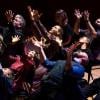
It was a weekend for death and remembrance at The Music Center.
On Saturday, a resplendent Day of the Dead altar and skeleton dancers greeted the audience arriving for the opening night of Gabriela Lena Frank’s El ùltimo sueño de Frida y Diego at Los Angeles Opera.
The next night, across the street in Walt Disney Concert Hall, the spirits of the dead were invoked very differently by the Los Angeles Master Chorale. The program featured the world premiere of Billy Childs’s In the Arms of the Beloved and an anniversary performance of Morten Lauridsen’s Lux Aeterna.
Presented on one of the final concerts of the California Festival, In the Arms of the Beloved is a gently rhapsodic work — a classical-jazz fusion conceived by Childs to celebrate the life and passing of his mother Mabel, who was a locally renowned schoolteacher. The work’s text and title are drawn from a poem by Rumi, but it’s the variety of forces Childs combines that imbues the piece with its unique sound.

Under the baton of Artistic Director Grant Gershon, In the Arms of the Beloved brought together the full strength of the Master Chorale with solo instrumental roles for Childs at the piano and violin virtuoso Anne Akiko Meyers. A wide range of additional colors came from the Lyris Quartet (violinists Alyssa Park and Shalini Vijayan, violist Luke Maurer, and cellist Timothy Loo) and the four members of Childs’s Jazz Chamber Ensemble: guitarist Larry Koonse, harpist Carol Robbins, bassist Dan Chmielinski, and drummer Christian Euman.
As the Master Chorale intoned the words of the poem, with it many spiritual metaphors of birds taking flight, the music evoked images of a human spirit rising ever higher on a transcendent journey. The string quartet and jazz ensemble provided an abundance of atmospheric details, with the jazz artists occasionally taking the spotlight for solo statements.
Drawing cues from the text, Childs constructs a series of rhythmic, vocal, and harmonic shifts driven by drum rhythms, rapid bowing attacks from the quartet, and flutters of ascension in the vocal lines. The choral parts are superbly shaped and defined to meld with the emotion of the poem.

But the most engrossing and moving aspect of In the Arms of the Beloved was the back-and-forth between Meyers’s solo violin and Childs’s piano, as if they were taking part in an imaginary conversation between mother and son. Their musical exchanges, like wisps of memory, were a heartfelt dialogue and climaxed in a pair of extended cadenzas.
Gershon, who has overseen and nurtured the piece from its inception, conducted with a combination of grace and vigor that allowed all of Childs’s disparate elements to come together and shine.
Shining light and the loss of one’s mother are features that connect In the Arms of the Beloved and Lauridsen’s Lux Aeterna.
Of the work, Lauridsen wrote, “I composed Lux Aeterna in response to my mother’s final illness and found great personal comfort and solace in setting to music these timeless and wondrous words about Light, a universal symbol of illumination at all levels — spiritual, artistic, and intellectual.”

Premiered in 1997 by the Master Chorale (then under the leadership of Paul Salamunovich), Lux Aeterna ignited, according to Gershon, a new wave of contemporary choral composition and has become one of the most frequently performed modern orchestral-choral pieces.
It opens and closes with the traditional beginning and ending liturgy of the requiem Mass. The central three movements are drawn respectively from the Latin hymns Te Deum, O nata lux, and Veni, Sancte Spiritus.
Renowned for its luminous choral textures, the work is decidedly conservative and rooted in medieval plainsong. As Gershon pointed out during a preconcert talk, “These are melodies that could have been composed a thousand years ago.”
Clearly this is a piece that Gershon feels deeply about, and he conducted it with a combination of reverence and uplifting joy, seeing in the work an expression of spiritual transcendence over death as a realm of doom and despair.




